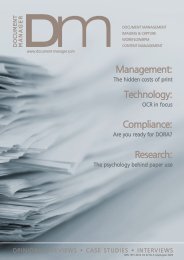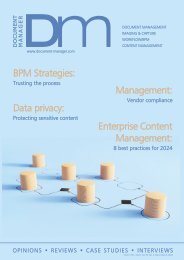CS Nov-Dec 2020
You also want an ePaper? Increase the reach of your titles
YUMPU automatically turns print PDFs into web optimized ePapers that Google loves.
hacking surge<br />
Adrian Rowley, Gigamon: a much stricter<br />
privilege regulation policy is needed - a<br />
Zero Trust one.<br />
Joe Hancock, MDR Cyber: "Many of the<br />
targets of sophisticated cyber-attacks are<br />
nameless or their experience is tempered<br />
by being part of an organisation that can<br />
protect them.<br />
many ways remain the same, points out<br />
Chris Goettl, director of security solutions,<br />
Ivanti. "This means businesses can cut<br />
through this sophistication and prioritise<br />
measures to maximise their cybersecurity<br />
strategies. For this reason, they should look<br />
to cybersecurity frameworks, such as the<br />
CIS Critical Security Controls.<br />
THE RIGHT MEASURES<br />
"By following the top five CIS guidelines<br />
and adhering to basic cyber hygiene<br />
measures, it's possible to eliminate 85%<br />
of modern cyber threats. Take vulnerability<br />
management, for example: if IT and<br />
security teams don't treat vulnerability<br />
management as an ongoing process,<br />
business infrastructure will be exposed,<br />
as hackers can find and weaponise<br />
vulnerabilities faster than these teams can<br />
patch. Automating this process can further<br />
protect the organisation by minimising the<br />
gap between the onset of new knowledge<br />
and remediation, reducing the period in<br />
which cybercriminals can strike."<br />
Goettl also recognises how businesses<br />
have faced an entirely new security<br />
challenge over recent months due to<br />
the added risks of a remote workforce.<br />
"For companies that weren't prepared to<br />
support remote workers, this was a drastic<br />
change. It's important that IT and security<br />
teams implement tailored measures to<br />
counter this drastic shift in attack surface,<br />
as remote working looks set to continue in<br />
some capacity for the foreseeable future.<br />
"For example,", he also points out,<br />
"patching a remote or fluid workforce may<br />
require the implementation of a hybrid or<br />
cloud-based patch management solution<br />
that can implement patches to companyowned<br />
devices and BYOD, and that won't<br />
take up valuable VPN bandwidth with<br />
update traffic."<br />
With workers undefended away from their<br />
offices and targeted by malicious actors,<br />
companies must keep security front of<br />
mind as they familiarise themselves with<br />
the 'new normal', says Adrian Rowley,<br />
senior director Sales Engineering EMEA at<br />
Gigamon. "As flexible working becomes the<br />
go-to, employees will be shifting between<br />
on-premise and remote working,<br />
combining user-owned and company<br />
devices (not to mention personal WiFi<br />
connections). This will make network<br />
perimeters even harder to define and<br />
to protect.<br />
"Traffic flows will also be impacted,<br />
with users switching from LAN to WAN<br />
and back - so inspecting encrypted and<br />
unencrypted data will be critical for IT and<br />
security teams to keep abreast of potential<br />
threats. Ultimately, the only way to drive<br />
security in these difficult circumstances is<br />
minimising blind spots and ensuring<br />
unclouded visibility throughout the<br />
network."<br />
To create security resilience in times of<br />
uncertainty, companies must move away<br />
from the idea that any asset or user within<br />
the network perimeter can be trusted, and<br />
a much stricter privilege regulation policy is<br />
needed - in other words, a Zero Trust (ZT)<br />
architecture, he continues. "This security<br />
strategy consists of scrutinising asset<br />
behaviour and only granting access based<br />
on this information, rather than based on<br />
pre-existing credentials. Because it's<br />
impossible to monitor what you can't see,<br />
companies need a clear view of everything<br />
that happens on their network to enable<br />
a ZT approach. "What many businesses<br />
haven't grasped yet is that ZT isn't a<br />
product they can buy, deploy and use to<br />
dispel their security woes," states Rowley.<br />
"It's a mindset which must be applied to<br />
every IT and security decision. Shifting<br />
to a ZT model is no easy feat, but it's<br />
imperative to ensure fool-proof protection<br />
at a time when IT environments are<br />
complicated by a fluid workforce and<br />
cyberattacks are fiercer than ever."<br />
28<br />
computing security <strong>Nov</strong>/<strong>Dec</strong> <strong>2020</strong> @<strong>CS</strong>MagAndAwards www.computingsecurity.co.uk

















